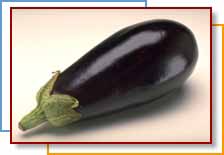
Eggplant is a member of the nightshade family and is native to India.
The early varieties were bitter, but cultivation and crossbreeding have
greatly improved the flavor. Eggplant is related to potatoes, tomatoes,
and peppers.
Eggplant isn't a particularly popular vegetable in the United States, but
it's a favorite in many areas of the South. Thomas Jefferson, who
experimented with many varieties of plants in his Virginia garden, is
credited with introducing eggplant to North America.
Florida produces the bulk of the domestic harvest, and New Jersey is a
major supplier during the summer months.
| |
|
Eggplant |
Serving Size
1/2 cup cubed, cooked (50g)
|
Amount Per Serving |
% Daily Value |
| Calories 15 |
|
| Calories from Fat 0g |
|
| Total Fat
0g |
0% |
|
Saturated Fat 0g |
0% |
| Sodium
0mg |
0% |
| Total
Carbohydrate 4g |
1% |
| Dietary
Fiber 1g |
4% |
| Sugars
2g |
|
| Protein 0g |
|
| Vitamin
A |
0% |
| Vitamin C |
2% |
| Calcium |
0% |
| Iron |
0% |
* Percent Daily Values are based on a
2,000 calorie diet.
|
|
| |
|
The dark purple eggplants are the most common type sold commercially in
the United States. They weigh about 1 to 5 pounds each and come in two
shapes: oval and elongated. The elongated variety is often referred to as
the Japanese or oriental eggplant.
Specialty varieties include miniature eggplants that come in a variety
of colors and shapes.
- Deep purple, round or oval eggplants are often nicknamed Italian or
baby eggplants.
- Pale violet eggplant, usually slim and light, is nicknamed Chinese
eggplant.
- Violet-white are Italian rosa biancos
- Japanese eggplants are younger versions of the large commercial
purple type.
Eggplants are available all year. Their peak growing season in the
United States is from July to October.
Look for a symmetrical eggplant with smooth, uniformly colored skin.
Tan patches, scars, or bruises indicate decay. Also avoid eggplants with
wrinkled or flabby-looking skin. Oversized purple eggplants, usually over
6 inches in diameter, may be tough and bitter.
When you press gently on an eggplant, the finger mark will disappear
quickly if the eggplant is fresh. Eggplant should feel heavy; one that
feels light for its size may not have a good flavor. The stem and cap
should be bright green.
Both cold and warm temperatures can damage eggplant. It is best to
store eggplant uncut and unwashed in a plastic bag in the cooler section
of the refrigerator. Do not force the eggplant into the crisper if it is
too big, as this will bruise the vegetable. Eggplant may be blanched or
steamed then frozen for up to 6 months.
Wash the eggplant just before using it, and cut off the cap and stem.
Use a stainless steel knife because carbon blades will discolor the
eggplant. Eggplant should not be eaten raw. Eggplant may be cooked with or
without its skin. However, large eggplant and most white varieties have
thick, tough skin and should be peeled prior to cooking with a vegetable
peeler.
Unlike many vegetables, eggplant is not harmed by long cooking. An
undercooked eggplant can have a chewy texture; but overcooked eggplant is
just very soft. Do not cook in an aluminum pot because the eggplant will
become discolored.
Spices that enhance its flavor include allspice, basil, bay leaves,
garlic, chili powder, oregano, sage, thyme, marjoram, and parsley.
Eggplant is most often paired with tomatoes or onions.
Baking: To bake a whole eggplant, pierce the skin with a fork several
times, and cook it at 400 degrees for 30 to 40 minutes. Baking whole
eggplants produces a soft flesh that is easy to mash or puree.
Broiling: Cut the eggplant into thick lengthwise slices, and score them
lightly with a sharp knife. Place the slices on a broiler pan or grill;
brush them lightly with oil. Broil about 5 inches from the heat, and turn
slices when they begin to brown. Eggplant should be cooked for
approximately 5 minutes per side.
Eggplant may also be microwaved whole, cubed, or sliced. Cooking times
vary from 6 to 8 minutes for a whole eggplant to 3 or 4 minutes for a
pound of cubed eggplant.
Stewed eggplant is called ratatouille. For this dish, eggplant may be
stewed alone, or with other vegetables. Simmer, covered with a liquid such
as tomato juice, until the eggplant is tender. The cooking time is usually
20 to 25 minutes.
Recipes

Stuffed Eggplant
4 servings
Each serving equals 2 cups of fruit or vegetables
Ingredients
1½ cups bread crumbs
2 eggplants
2 tomatoes, diced
½ cup green bell pepper, diced
½ cup onion, diced
1/3 cup celery, diced
1/8 Tbsp. salt
¼ Tbsp. black pepper
2 Tbsp. fresh parsley, minced
2 Tbsp. parmesan cheese
Vegetable cooking spray
Preheat oven to 350 degrees F.
Cut eggplants in half lengthwise. Scoop out and save the flesh, leaving
the shells 3/8-inch thick. If necessary, trim a small piece off the bottom
of each shell so it won't tip over. Set aside.
Coat large skillet with vegetable cooking spray. Chop up reserved eggplant and add to skillet. Add tomato, bell pepper, onion, celery, salt, and
black pepper. Place skillet over medium heat; cover and cook about 5 minutes, until vegetables are tender.
Remove skillet from heat. Stir in bread crumbs and parsley. Spoon mixture into the hollow eggplant shells.
Arrange stuffed shells in a shallow baking dish coated with vegetable
spray. Sprinkle 1½ tsps Parmesan on top of each shell. Bake for 25
minutes, until filling heats through and top is golden brown.
Nutritional analysis per serving: Calories 269, Fat 3g, Calories from
Fat 10%, Protein 9g, Carbohydrates 52g, Cholesterol 1mg, Fiber 9g, Sodium
419mg.
Find more in our
recipe database!
|



